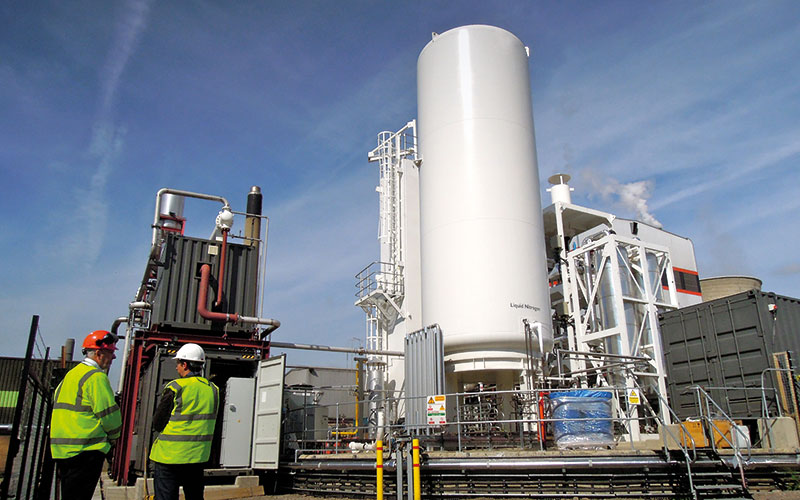A new era for energy storage
For grid stability, long-duration energy storage is necessary and urgent, says Dr Javier Cavada at Highview Power

Market demand, coupled with competitive prices, have helped to spur unprecedented levels of renewable deployments in recent years. However, there are still significant hurdles to the achievement of 100% carbon-free electricity. Intermittency is perhaps the most well-known issue, but recently a much more difficult problem has arisen – making renewables grid-synchronous in order to ensure grid stability and reliability.
The power of synchronicity
On 9 August 2019, the UK grid suffered a near-simultaneous failure of two power generation facilities – the Little Barford gas-fired power station and the Hornsea offshore wind farm. The UK’s most severe blackout in more than a decade caused rush hour travel disruption across its biggest train stations, railways, roads and airports, and left almost a million homes across the country in the dark. As the investigation continues, many attribute the outage to a sudden drop in grid frequency due, in large part, to decreasing synchronicity in the grid’s power supply.
Synchronicity, as well as inertia and frequency, are gaining attention from grid operators as they seek to balance constant power and the integration of increasing shares of intermittent renewables into the grid. To this end, grid-synchronous, long-duration energy storage is key to modernising the grid.
Long-duration energy storage
A crucial benefit of giga-scale, long-duration energy storage is that these systems can provide services at all levels of the electricity system – supporting power generation, providing stabilisation services to transmission grids and distribution networks, and acting as a source of back-up power to end users.
There are a few grid-synchronous energy storage technologies – pumped-hydro and compressed air, for example – and each has its own geographic constraint. Pumped-hydro relies on dramatic elevation changes and compressed air requires large underground caverns, rendering each suitable only for certain geographies. Other energy storage options, like electrochemical batteries, are most suitable for small-scale and short-duration services. In addition, they require significant costs to scale up to higher power capacities and cannot provide the synchronous inertia needed or the levels of voltage control for grid stability.
Cryogenic energy storage
One utility-scale technology that enables grid operators to maximise renewable penetration is Highview Power’s cryogenic energy storage system, which produces zero emissions, uses only benign materials and does not require the use of water in the energy storage process. In addition, it is particularly well-suited for providing grid-scale storage due to its capacity and ability to be sited at the point of demand. Relying on mature components, it can be deployable immediately, while other energy storage technologies await testing, maturation or continued development.
The system cools ambient air to its liquid state, which results in a 700-fold decrease in volume. The liquefied air is then stored in containers similar to those used for liquefied natural gas until energy is needed. In this process, energy is stored in the volume differential of gaseous and liquid air. When reheated, the liquid air expands to its original volume, creating enough pressure to drive a turbine. A cryogenic system is the only long-duration energy storage solution available today that offers multiple gigawatt hours of storage, representing multiple days’ worth of storage, not just minutes or hours.
Power grid fragility
Due to the inability to unilaterally generate power and keep the grid stable, energy storage must fill this lapse in renewable injections and supplement other grid shortcomings. Historically, transmission network failures have caused the majority of power failures. Today, however, without a grid-synchronous energy storage technology, and as renewables contribute increasingly more to the grid, we may be re-entering an era where the generation of power itself contributes more to outages than transmission network failures.
The precariousness of the grid’s transmission network is evident in the widespread blackouts encountered across the globe in recent months. In June, a multi-country outage across Argentina, Uruguay, Chile, and Paraguay left millions without electricity for more than seven hours. Caused by a ‘massive failure’ of the grid that serves these countries, the outage affected more than 48 million people. In July, parts of New York City were left without power as a result of a substation failure, affecting tens of thousands of consumers.
In early August, tens of millions of Indonesians were affected by a nine-hour transmission line failure. Days later, the UK was affected by the aforementioned hours-long outage. These events do not indicate regional transmission network aberrations, but rather demonstrate the global fragility of power grids and should prompt universal concern over grid stability and reliability in transmission networks.
Of course, resolving the fragility of the existing transmission network altogether is wishful thinking. However, alleviating extensive downstream impacts of localised events can be accomplished. Cryogenic energy storage facilities tied to community wind or solar energy generation arrays can help reduce the number of affected consumers during events.
Modernising the energy grid
As renewables continue to rapidly grow and become the preferred mainstream energy source in the bid to slash emissions, it is important to protect the stability and strengthen the resilience of the grid by continuing to develop and promote all forms of energy storage – especially long-duration, grid-synchronous energy storage technologies including cryogenic energy storage. Only with this type of giga-scale long-duration energy storage will renewables become reliable enough to become the baseload source of power.
By Dr Javier Cavada, President and CEO, Highview Power






Follow us
Advertise
Free e-Newsletter